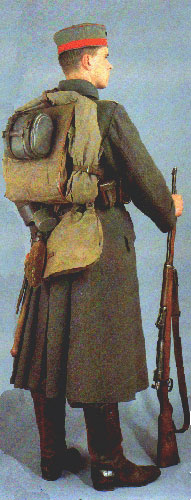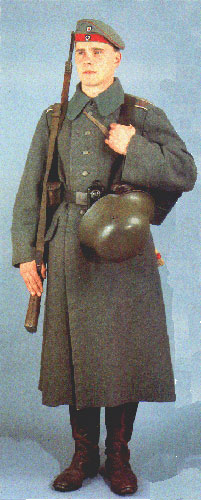|
1. M.1910 Feldmütze (field cap) in field grey cloth, its band and piping in the distinctive arm-of-service color, here the red of the infantry. Two small pressed metal cockades are sewn to the front: on the crown were the national colors of black, white and red, and on the band were the colors of the regiments state of origin (here the black and white of Prussia). After the first year or so of the war, this cap was usually only worn behind the lines. In 1917, a drabber version of the Feldmütze, called the Einheitsfeldmütze with an “all-arms” pea-green band was introduced, but the old style Feldmütze continued in use alongside it, usually with a drab-colored cloth strip fitted over the red band.
2. M.1915 Mantel (greatcoat) in feldgrau, the large fall collar faced with green, as on the Bluse. It fastened with six large uniform buttons, and had two large flapped pockets in the sides, set at a slant. Although often sewn down, the Achselklappen (shoulder straps) were officially of detachable type, and bore the same red unit number or monogram as on the Bluse. [shown here with a set of Achselklappen from a Feldbluse--Achselklappen for Mantels did not have the piping]
3. M.1916 Stahlhelm (steel helmet); here in monochrome grey, by 1918, they were often painted with colored camouflage pattern. Here the Stahlhelm is shown looped to the belt by its chinstrap.
4. M.1895 Koppel (belt) in blackened leather, the M.1915 Koppelschloß (buckle) painted field grey, here of Prussian design with a crown and the motto „Gott Mit Uns“.
5. Taschenlampe (Flashlight) in black-painted metal, a non-regulation accessory sometimes seen fixed to a button by means of a leather tab, or, as here, looped to the belt.
6. M.1909 Patronentaschen (cartridge pouches) of ersatz manufacture, in vulcanized fiber. Like the leather originals, they carried three Ladestreifen (stripper-clips) in each of the three pouches of each set, giving a total load of 90 rounds.
7. M.1895 Tornister, here of simplified wartime manufacture in a greyish canvas. It accommodated reserve rations and changes of clothing. The M.1892 Zeltbahn (tent/shelter-quarter) is rolled round the Tornister and fixed with leather straps. A wartime-made Kochgeschirr (mess kit) of M.1910 design is strapped to the Tornister flap.
8. M.1887 Brotbeutel (breadbag or haversack) in the greyish-colored fabric often seen in equipment of wartime manufacture.
9. The M.1907 Feldflasche (canteen) in enameled iron, covered with recycled cloth-in this case, with brown corduroy. The attachment system had been simplified by this date to a single snap hook engaging with one of the rings mounted on the breadbag.
10. M.1893 Trinkbecher (cup); for economy, green-enameled iron was now used in place of the earlier aluminum. Its handle is secured by the attachment loop of the breadbag, inside which it was officially supposed to be stowed.
11. M.1917 Lederschutzmaske (gasmask) in proofed leather, in its grey-painted canister slung on a fabric strap.
12. The Schanzzeug, here the M.1887 Schanzzeug (spade), with the scabbard of the Seitengewehr (bayonet) secured to it by a strap. Note the Troddel (bayonet knot) in Kompagnie colors.
13. Perhaps unusually for this date, this young man has a pair of the early-war issue M.1886 Marschstiefel (marching boots) the tan leather blackened according to regulations.
14. M.1898 Mauser Gewehr 98 (rifle ‘98), in 7.92x57mm caliber; this sling is of ersatz manufacture, of fabric with leather ends.
|





